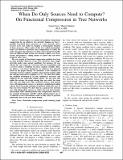When do only sources need to compute? On functional compression in tree networks
Author(s)
Medard, Muriel; Feizi-Khankandi, Soheil
DownloadFeizi-2009-When do only sources need to compute On functional compression in tree networks.pdf (252.9Kb)
PUBLISHER_POLICY
Publisher Policy
Article is made available in accordance with the publisher's policy and may be subject to US copyright law. Please refer to the publisher's site for terms of use.
Terms of use
Metadata
Show full item recordAbstract
In this paper, we consider the problem of functional compression for an arbitrary tree network. Suppose we have k possibly correlated source processes in a tree network, and a receiver in its root wishes to compute a deterministic function of these processes. Other nodes of this tree (called intermediate nodes) are allowed to perform some computations to satisfy the node's demand. Our objective is to find a lower bound on feasible rates for different links of this tree network (called a rate lower bound) and propose a coding scheme to achieve this rate lower bound in some cases. The rate region of functional compression problem has been an open problem. However, it has been solved for some simple networks under some special conditions. For instance, Doshi et al. (2007) considered the rate region of a network with two transmitters and a receiver under a condition on source random variables. Here, we derive a rate lower bound for an arbitrary tree network based on the graph entropy. We introduce a new condition on colorings of source random variables' characteristic graphs called the coloring connectivity condition (C.C.C.). We show that unlike the condition mentioned in the work of Doshi et al. (2007), this condition is necessary and sufficient for any achievable coding scheme. We also show that unlike the entropy, the graph entropy does not satisfy the chain rule. For one stage trees with correlated sources, and general trees with independent sources, we propose a modularized coding scheme based on graph colorings to perform arbitrarily close to this rate lower bound. We show that in a general tree network case with independent sources, to achieve the rate lower bound, intermediate nodes should perform some computations. However, for a family of functions and RVs called coloring proper sets, it is sufficient to have intermediate nodes act like relays to perform arbitrarily close to the rate lower bound.
Date issued
2010-01Department
Massachusetts Institute of Technology. Department of Electrical Engineering and Computer Science; Massachusetts Institute of Technology. Research Laboratory of ElectronicsJournal
47th Annual Allerton Conference on Communication, Control, and Computing, 2009. Allerton 2009
Publisher
Institute of Electrical and Electronics Engineers
Citation
Feizi, S., and M. Medard. “When do only sources need to compute? On functional compression in tree networks.” Communication, Control, and Computing, 2009. Allerton 2009. 47th Annual Allerton Conference on. 2009. 447-454. ©2010 Institute of Electrical and Electronics Engineers.
Version: Final published version
Other identifiers
INSPEC Accession Number: 11089573
ISBN
978-1-4244-5870-7
Keywords
Functional compression, graph coloring, graph entropy